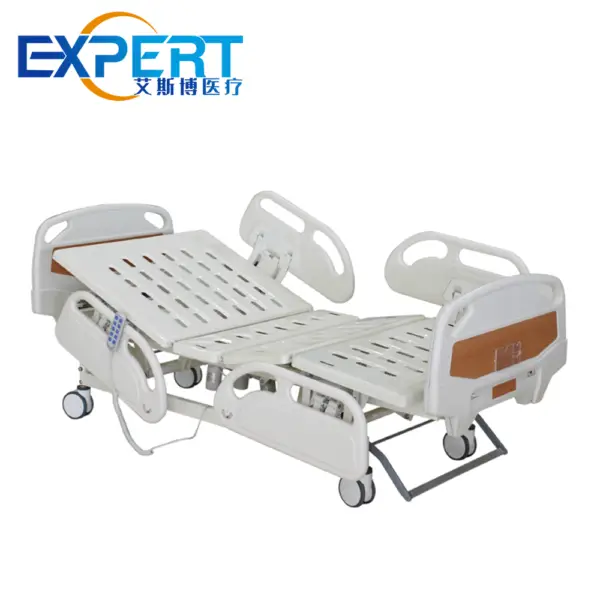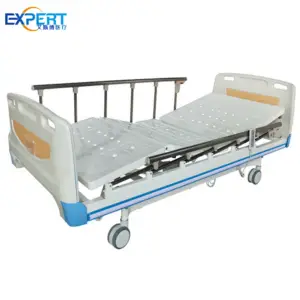Die Anschrift
304 Nordkardinal St.
Dorchester Center, MA 02124
Arbeitsstunden
Montag bis Freitag: 7:00 - 19:00
Wochenende: 10:00 - 17:00
Willkommen auf meinem Blog!
Bevor wir uns in die Inhalte vertiefen, würde ich mich freuen, wenn Sie mir auf meinen Social-Media-Plattformen folgen, wo ich weitere Einblicke gebe, mit der Community interagiere und Updates poste. So können Sie mit mir in Kontakt treten:
Facebook:https://www.facebook.com/profile.php?id=100071234835011
LinkedIn:https://www.linkedin.com/company/74943205/admin/dashboard/
YouTube:www.youtube.com/@shandongexpertmedicalequip4695
TikTok:www.tiktok.com/@expertmedical
Lassen Sie uns nun gemeinsam unsere Reise beginnen. Ich hoffe, Sie finden die Inhalte hier aufschlussreich, spannend und wertvoll.

Krankenhausbetten sind wichtige medizinische Geräte, die in Gesundheitseinrichtungen verwendet werden, um Patienten während ihrer Genesung oder Behandlung Komfort, Unterstützung und Sicherheit zu bieten. Einer der wichtigsten Aspekte beim Design von Krankenhausbetten sind die Abmessungen eines Krankenhausbetts. Diese Abmessungen stellen sicher, dass das Bett in eine Vielzahl von Umgebungen passt, den unterschiedlichen Bedürfnissen der Patienten gerecht wird und mit anderen medizinischen Geräten kombinierbar ist. In diesem Blogbeitrag untersuchen wir die Standardmaße für ein Krankenhausbett, wie sie sich auf die Patientenversorgung auswirken und welche Faktoren bei der Auswahl eines Krankenhausbetts berücksichtigt werden sollten.
Hospital beds come in different sizes to accommodate the needs of various patients. The dimensions for a hospital bed can vary slightly depending on the type of bed (manual or electric) and the specific requirements of the healthcare setting. However, there are standard measurements that most hospital beds follow to ensure consistency and compatibility across medical facilities.

The standard dimensions for a hospital bed include a length of 80 inches and a width of 36 inches. This is the typical size for most adult hospital beds, designed to fit most patients comfortably while allowing for easy access by healthcare professionals.
One of the key features of modern hospital beds is their ability to adjust to different positions to provide better comfort and facilitate medical procedures. Adjustable hospital beds come with features such as head and foot elevation, which impact their overall dimensions for a hospital bed.









Different types of hospital beds are designed for specific medical or patient care needs. The dimensions for a hospital bed can vary slightly depending on the bed type.
Manual hospital beds are simple, cost-effective models that can be adjusted by hand. These beds typically feature a basic layout with adjustable sections for the head and foot of the bed. The standard dimensions for a hospital bed of this type remain consistent, but they offer less flexibility in terms of positioning than electric models.

Electric hospital beds offer greater convenience and flexibility, with motorized adjustments for the head, foot, and height. These beds allow for more precise positioning, which can improve patient comfort and make caregiving easier. The dimensions for a hospital bed with electric adjustments usually remain the same, though they can vary slightly due to the additional motors and mechanisms.
Bariatric hospital beds are designed specifically for overweight or obese patients, offering larger dimensions to accommodate a wider body frame and ensure better comfort. These beds often feature reinforced frames and wider widths to ensure safety and comfort.
Here’s a helpful table summarizing the dimensions for a hospital bed based on the type of bed:
| Bettentyp | Länge (Zoll) | Breite (Zoll) | Height Adjustment Range (inches) |
|---|---|---|---|
| Manuelles Krankenhausbett | 80 | 36 | 12-24 |
| Elektrisches Krankenhausbett | 80-84 | 36 | 12-24 |
| Bariatrisches Krankenhausbett | 80-84 | 42-54 | 12-24 |

Several factors influence the dimensions for a hospital bed and the choice of a particular bed for a healthcare facility. Some of the most important considerations include:
The dimensions for a hospital bed are designed to ensure that the patient is comfortable and safe. Larger beds, like bariatric beds, accommodate patients who require more space due to their size. The width and length of the bed should be suitable for the patient’s body size, while the height adjustment feature should allow for easy access by healthcare providers.
The available space in a hospital room or care facility may limit the dimensions of the bed that can be accommodated. For smaller rooms, a standard manual bed may be preferred due to its compact size. On the other hand, larger rooms with more space may allow for bariatric or electric beds, which offer more features but require additional space.
Some patients may require special beds based on their medical needs. For example, electric hospital beds are suitable for patients who need frequent position changes, while bariatric beds are essential for heavier patients. The dimensions for a hospital bed should accommodate the patient’s needs, medical condition, and care requirements.
Hospital beds are manufactured according to strict regulations and standards set by organizations like the Food and Drug Administration (FDA) and the International Organization for Standardization (ISO). These standards ensure that hospital bed dimensions are consistent and safe for use in healthcare facilities. It’s essential to ensure that the bed you select complies with these regulations.
Verstehen der dimensions for a hospital bed is crucial when selecting the right equipment for healthcare settings. Standard bed dimensions, like 80 inches in length and 36 inches in width, accommodate most adult patients, but different types of beds, such as manual, electric, and bariatric models, offer various options to meet the specific needs of patients. The right bed size contributes to patient comfort, caregiver ease, and overall healthcare efficiency.
The standard dimensions for a hospital bed are typically 80 inches in length and 36 inches in width. This size suits most adult patients.
Yes, many hospital beds are adjustable in height, head, and foot positions to improve patient comfort and assist healthcare providers in delivering care.
A bariatric hospital bed is designed to accommodate overweight or obese patients. It is typically wider (42-54 inches) and often has additional support to ensure safety and comfort.
When selecting a hospital bed, consider the patient’s size, medical condition, and the available space in the room. Electric beds offer more flexibility, while bariatric beds are designed for larger patients.
Yes, choosing the right hospital bed with the appropriate dimensions can significantly impact patient comfort, safety, and overall recovery. It also facilitates more efficient caregiving.
